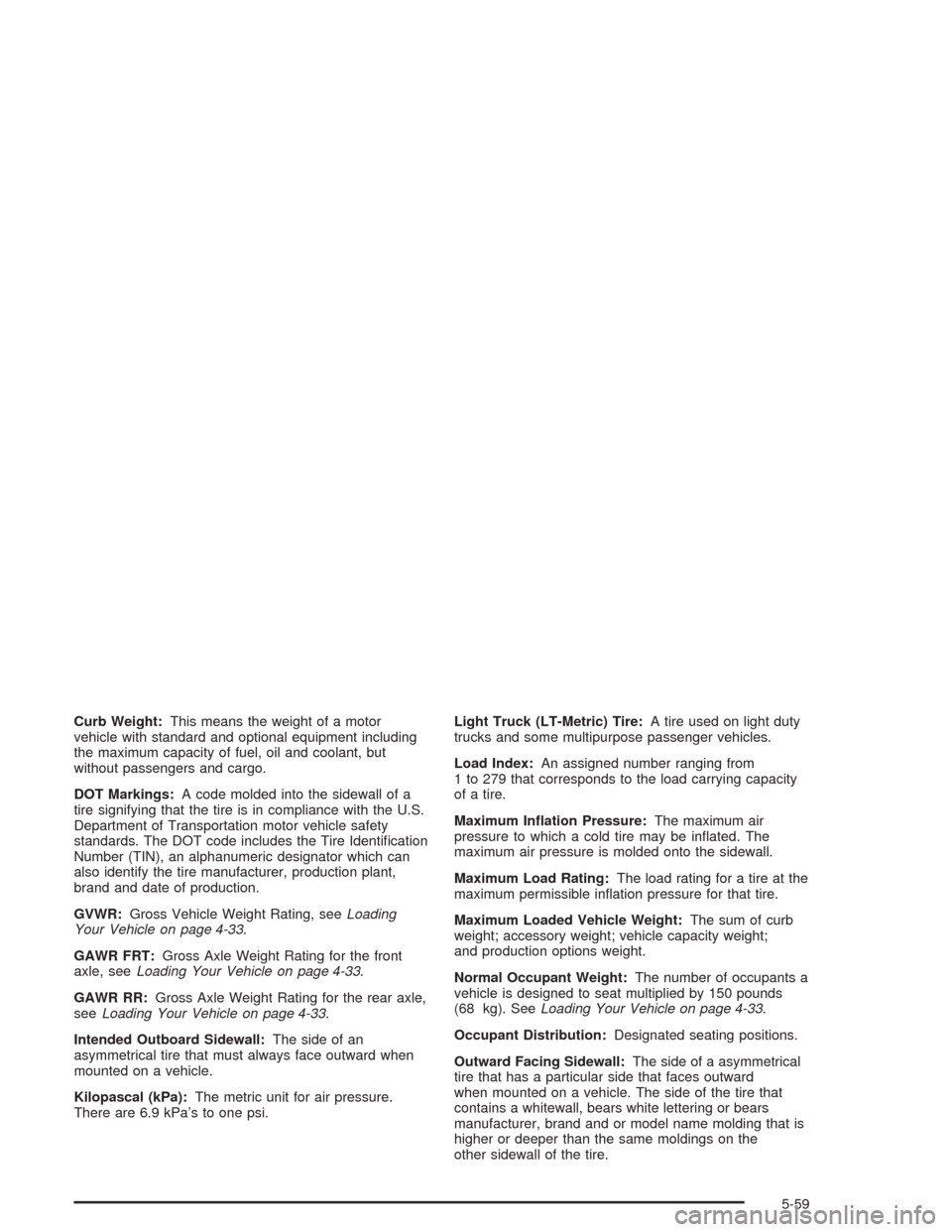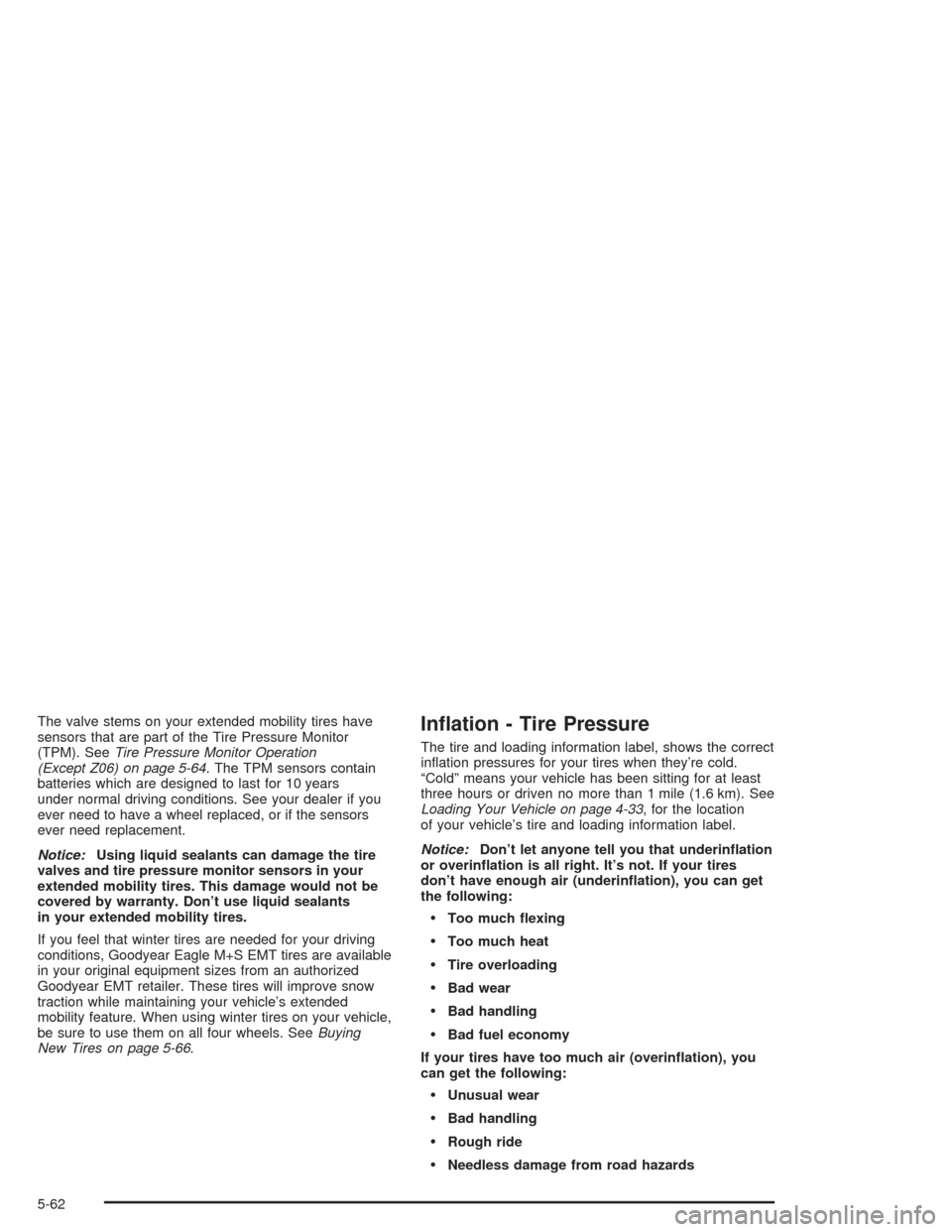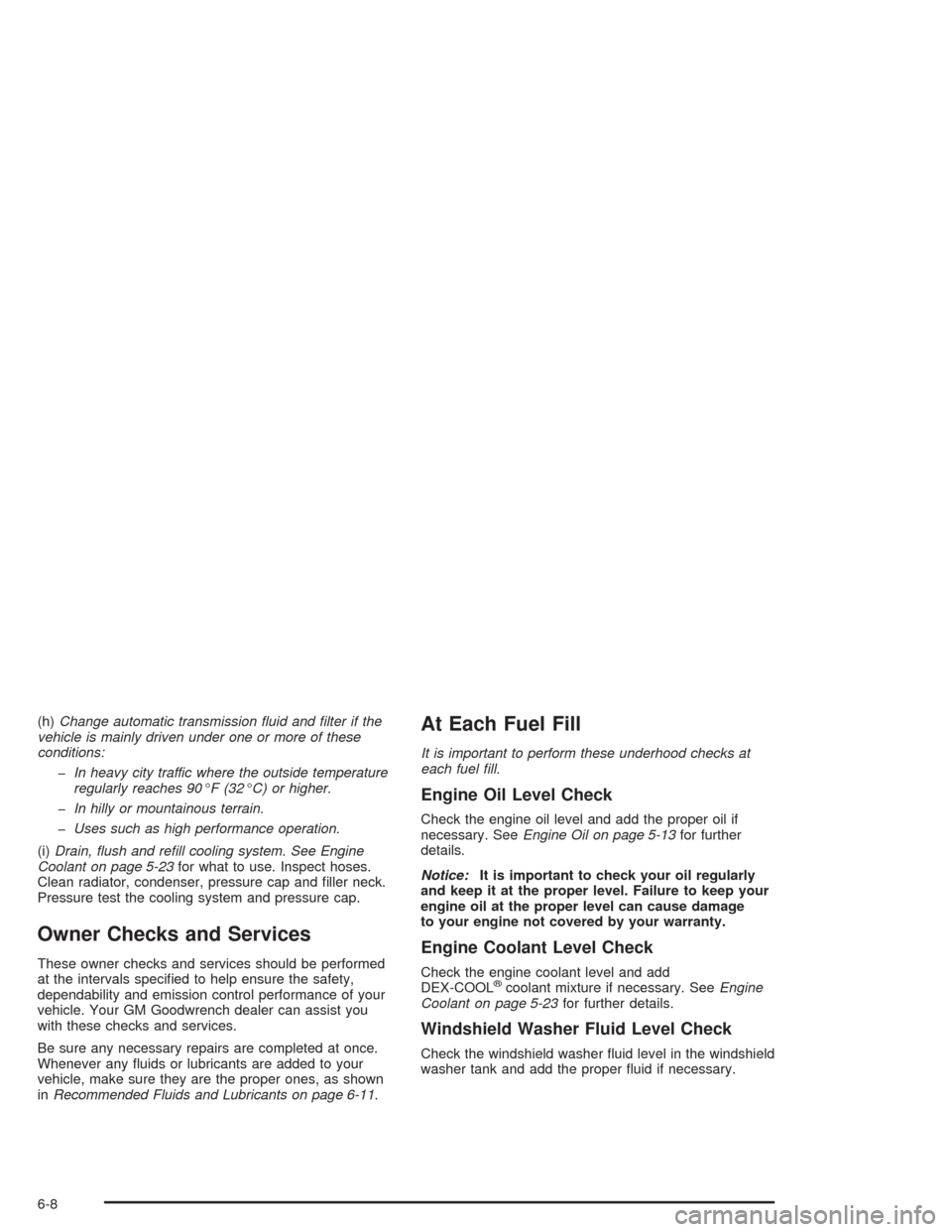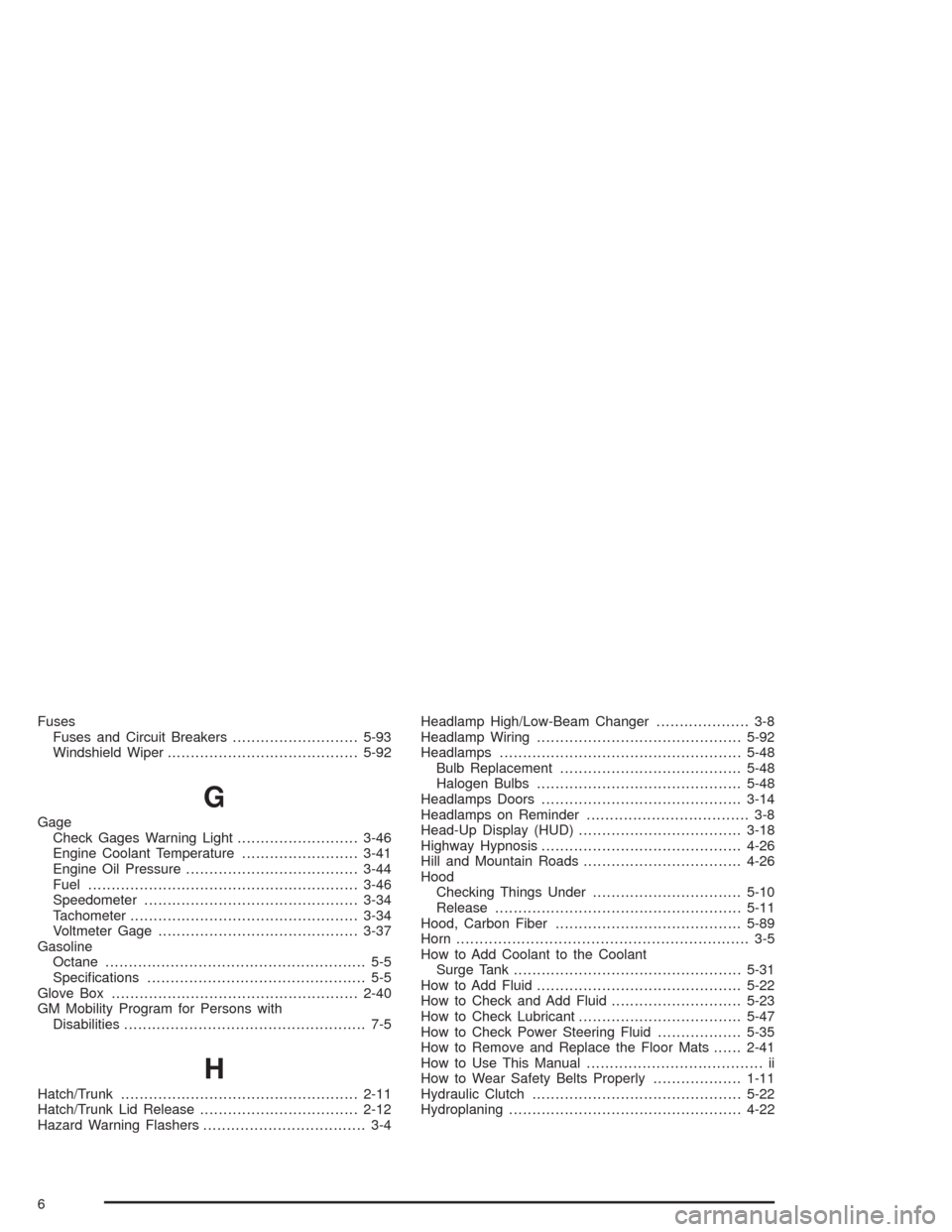2004 CHEVROLET CORVETTE fuel pressure
[x] Cancel search: fuel pressurePage 255 of 384

A. Coolant Surge Tank and Pressure Cap. SeeEngine
Coolant on page 5-23.
B. Battery. SeeBattery on page 5-40.
C. Engine Oil Dipstick. SeeEngine Oil on page 5-13.
D. Engine Oil Fill Cap. SeeEngine Oil on page 5-13.
E. Engine Air Cleaner/Filter. SeeEngine Air
Cleaner/Filter on page 5-18.
F. Power Steering Fluid Reservoir. SeePower Steering
Fluid on page 5-35.
G. Brake Fluid Reservoir. SeeBrakes on page 5-37.
H. Clutch Master Cylinder Reservoir. SeeHydraulic
Clutch on page 5-22.
I. Windshield Washer Fluid Reservoir. SeeWindshield
Washer Fluid on page 5-36.Engine Oil
If the LOW OIL LEVEL message on the Driver
Information Center comes on, it means you need to
check your engine oil level right away. For more
information, seeDriver Information Center (DIC) on
page 3-48.
You should check your engine oil level regularly; this is
an added reminder.
Checking Engine Oil
It is a good idea to check your engine oil level every
time you get fuel. In order to get an accurate reading,
the oil must be warm and the vehicle must be on
level ground.
The engine oil dipstick handle is a yellow loop. See
Engine Compartment Overview on page 5-12for
the location of the engine oil dipstick.
Turn off the engine and give the oil a few minutes to
drain back into the oil pan. If you don’t, the oil dipstick
might not show the actual level.
Pull out the dipstick and clean it with a paper towel or a
cloth, then push it back in all the way. Remove it
again, keeping the tip down.
5-13
Page 301 of 384

Curb Weight:This means the weight of a motor
vehicle with standard and optional equipment including
the maximum capacity of fuel, oil and coolant, but
without passengers and cargo.
DOT Markings:A code molded into the sidewall of a
tire signifying that the tire is in compliance with the U.S.
Department of Transportation motor vehicle safety
standards. The DOT code includes the Tire Identification
Number (TIN), an alphanumeric designator which can
also identify the tire manufacturer, production plant,
brand and date of production.
GVWR:Gross Vehicle Weight Rating, seeLoading
Your Vehicle on page 4-33.
GAWR FRT:Gross Axle Weight Rating for the front
axle, seeLoading Your Vehicle on page 4-33.
GAWR RR:Gross Axle Weight Rating for the rear axle,
seeLoading Your Vehicle on page 4-33.
Intended Outboard Sidewall:The side of an
asymmetrical tire that must always face outward when
mounted on a vehicle.
Kilopascal (kPa):The metric unit for air pressure.
There are 6.9 kPa’s to one psi.Light Truck (LT-Metric) Tire:A tire used on light duty
trucks and some multipurpose passenger vehicles.
Load Index:An assigned number ranging from
1 to 279 that corresponds to the load carrying capacity
of a tire.
Maximum In�ation Pressure:The maximum air
pressure to which a cold tire may be inflated. The
maximum air pressure is molded onto the sidewall.
Maximum Load Rating:The load rating for a tire at the
maximum permissible inflation pressure for that tire.
Maximum Loaded Vehicle Weight:The sum of curb
weight; accessory weight; vehicle capacity weight;
and production options weight.
Normal Occupant Weight:The number of occupants a
vehicle is designed to seat multiplied by 150 pounds
(68 kg). SeeLoading Your Vehicle on page 4-33.
Occupant Distribution:Designated seating positions.
Outward Facing Sidewall:The side of a asymmetrical
tire that has a particular side that faces outward
when mounted on a vehicle. The side of the tire that
contains a whitewall, bears white lettering or bears
manufacturer, brand and or model name molding that is
higher or deeper than the same moldings on the
other sidewall of the tire.
5-59
Page 304 of 384

The valve stems on your extended mobility tires have
sensors that are part of the Tire Pressure Monitor
(TPM). SeeTire Pressure Monitor Operation
(Except Z06) on page 5-64. The TPM sensors contain
batteries which are designed to last for 10 years
under normal driving conditions. See your dealer if you
ever need to have a wheel replaced, or if the sensors
ever need replacement.
Notice:Using liquid sealants can damage the tire
valves and tire pressure monitor sensors in your
extended mobility tires. This damage would not be
covered by warranty. Don’t use liquid sealants
in your extended mobility tires.
If you feel that winter tires are needed for your driving
conditions, Goodyear Eagle M+S EMT tires are available
in your original equipment sizes from an authorized
Goodyear EMT retailer. These tires will improve snow
traction while maintaining your vehicle’s extended
mobility feature. When using winter tires on your vehicle,
be sure to use them on all four wheels. SeeBuying
New Tires on page 5-66.In�ation - Tire Pressure
The tire and loading information label, shows the correct
inflation pressures for your tires when they’re cold.
“Cold” means your vehicle has been sitting for at least
three hours or driven no more than 1 mile (1.6 km). See
Loading Your Vehicle on page 4-33, for the location
of your vehicle’s tire and loading information label.
Notice:Don’t let anyone tell you that underin�ation
or overin�ation is all right. It’s not. If your tires
don’t have enough air (underin�ation), you can get
the following:
Too much �exing
Too much heat
Tire overloading
Bad wear
Bad handling
Bad fuel economy
If your tires have too much air (overin�ation), you
can get the following:
Unusual wear
Bad handling
Rough ride
Needless damage from road hazards
5-62
Page 350 of 384

(h)Change automatic transmission �uid and �lter if the
vehicle is mainly driven under one or more of these
conditions:
-In heavy city traffic where the outside temperature
regularly reaches 90°F (32°C) or higher.
-In hilly or mountainous terrain.
-Uses such as high performance operation.
(i)Drain, �ush and re�ll cooling system. See Engine
Coolant on page 5-23for what to use. Inspect hoses.
Clean radiator, condenser, pressure cap and filler neck.
Pressure test the cooling system and pressure cap.
Owner Checks and Services
These owner checks and services should be performed
at the intervals specified to help ensure the safety,
dependability and emission control performance of your
vehicle. Your GM Goodwrench dealer can assist you
with these checks and services.
Be sure any necessary repairs are completed at once.
Whenever any fluids or lubricants are added to your
vehicle, make sure they are the proper ones, as shown
inRecommended Fluids and Lubricants on page 6-11.
At Each Fuel Fill
It is important to perform these underhood checks at
each fuel �ll.
Engine Oil Level Check
Check the engine oil level and add the proper oil if
necessary. SeeEngine Oil on page 5-13for further
details.
Notice:It is important to check your oil regularly
and keep it at the proper level. Failure to keep your
engine oil at the proper level can cause damage
to your engine not covered by your warranty.
Engine Coolant Level Check
Check the engine coolant level and add
DEX-COOL®coolant mixture if necessary. SeeEngine
Coolant on page 5-23for further details.
Windshield Washer Fluid Level Check
Check the windshield washer fluid level in the windshield
washer tank and add the proper fluid if necessary.
6-8
Page 375 of 384

Electrical System (cont.)
Windshield Wiper Fuses...............................5-92
Emergency Trunk Release Handle
(Convertible Only)........................................2-13
Emissions Inspection and
Maintenance Programs.................................3-44
Engine
Air Cleaner/Filter.........................................5-18
Battery.......................................................5-40
Check and Service Engine Soon Light............3-41
Coolant......................................................5-23
Coolant Heater............................................2-23
Coolant Temperature Gage...........................3-41
Drive Belt Routing.......................................6-14
Engine Compartment Overview......................5-12
Exhaust.....................................................2-36
Oil .............................................................5-13
Oil Pressure Gage.......................................3-44
Overheating................................................5-26
Starting......................................................2-21
Engine Compartment Fuse Block......................5-96
Engine Oil Additives........................................5-16
Event Data Recorders (EDR)............................. 7-9
Exit/Entry Lighting...........................................3-17
Express-Down Window....................................2-15
Extended Mobility Tires....................................5-61
Extender, Safety Belt.......................................1-19
Exterior Lamps...............................................3-13F
Filter
Engine Air Cleaner......................................5-18
Finding a Station....................................3-71, 3-77
Finish Care....................................................5-86
Finish Damage...............................................5-89
Fixed Mast Antenna........................................3-89
Flash-to-Pass................................................... 3-8
Flat Tire........................................................5-75
Floor Mats.....................................................2-41
Fluid
Automatic Transmission................................5-20
Manual Transmission....................................5-21
Power Steering...........................................5-35
Windshield Washer......................................5-36
FM ...............................................................3-88
Fog Lamps....................................................3-15
Front Air Dam................................................2-19
Fuel............................................................... 5-4
Additives...................................................... 5-6
California Fuel.............................................. 5-5
Filling a Portable Fuel Container....................5-10
Filling Your Tank........................................... 5-7
Fuels in Foreign Countries.............................. 5-6
Gage.........................................................3-46
Gasoline Octane........................................... 5-5
Gasoline Specifications.................................. 5-5
5
Page 376 of 384

Fuses
Fuses and Circuit Breakers...........................5-93
Windshield Wiper.........................................5-92
G
Gage
Check Gages Warning Light..........................3-46
Engine Coolant Temperature.........................3-41
Engine Oil Pressure.....................................3-44
Fuel..........................................................3-46
Speedometer..............................................3-34
Tachometer.................................................3-34
Voltmeter Gage...........................................3-37
Gasoline
Octane........................................................ 5-5
Specifications............................................... 5-5
Glove Box.....................................................2-40
GM Mobility Program for Persons with
Disabilities.................................................... 7-5
H
Hatch/Trunk...................................................2-11
Hatch/Trunk Lid Release..................................2-12
Hazard Warning Flashers................................... 3-4Headlamp High/Low-Beam Changer.................... 3-8
Headlamp Wiring............................................5-92
Headlamps....................................................5-48
Bulb Replacement.......................................5-48
Halogen Bulbs............................................5-48
Headlamps Doors...........................................3-14
Headlamps on Reminder................................... 3-8
Head-Up Display (HUD)...................................3-18
Highway Hypnosis...........................................4-26
Hill and Mountain Roads..................................4-26
Hood
Checking Things Under................................5-10
Release.....................................................5-11
Hood, Carbon Fiber........................................5-89
Horn............................................................... 3-5
How to Add Coolant to the Coolant
Surge Tank.................................................5-31
How to Add Fluid............................................5-22
How to Check and Add Fluid............................5-23
How to Check Lubricant...................................5-47
How to Check Power Steering Fluid..................5-35
How to Remove and Replace the Floor Mats......2-41
How to Use This Manual...................................... ii
How to Wear Safety Belts Properly...................1-11
Hydraulic Clutch.............................................5-22
Hydroplaning..................................................4-22
6